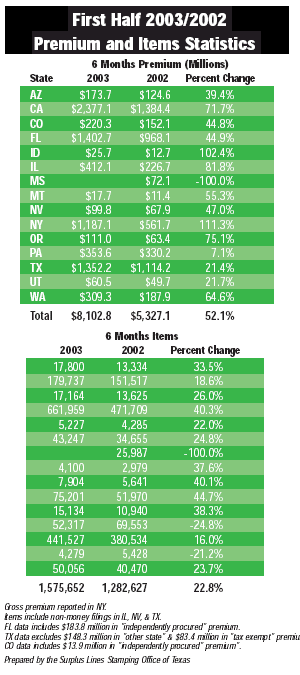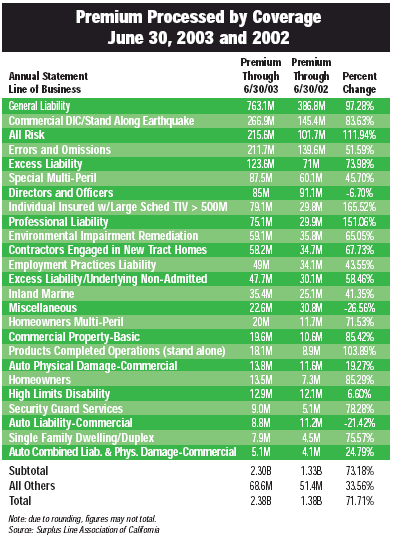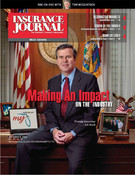Premium growth continues unabated for surplus line carriers, the insurance industry’s relief pitchers. They find themselves the beneficiaries of a standard marketplace still skittish about placing risks in lines beset by high losses, such as construction liability, directors and officers, and medical malpractice.
The year has so far seen no significant attempts by state regulators and politicians to restrict the freedoms of rate and form integral to surplus line carriers’ role as a secondary marketplace for risks too exotic for admitted markets driven into retrenchment mode by the hardened market.
Net written premium earned by surplus markets in the 14 states with stamping offices has grown by 52.1 percent to $8.1 billion in the first six months of 2003 over the first half of last year, according to data compiled by Phillip Ballinger, general manager of the Surplus Lines Stamping Office of Texas (SLSOT). The number of policies placed with surplus line carriers in those states also jumped 22.8 percent to 1.58 million.
As a whole the surplus lines industry is estimated to net as much as $24 billion in written premium in 2003, according to Richard Bouhan, executive director of the National Association of Professional Surplus Lines Offices. That would be a 21 percent increase from last year’s $15.6 billion take.
Meanwhile, surplus line carriers’ combined ratios continue to compare favorably with those of standard carriers. Through March 31, 2003, the last four quarters have seen the top surplus line carriers outrank the property/casualty industry aggregate combined ratio, according to data compiled by the ratings firm Demotech. While the industry as a whole almost stopped losing money on underwriting with a 101.11 percent combined ratio in the first quarter of this year, surplus line carriers had a return-on-investment ratio of approximately 93.13 percent.
“There’s still evidence of fairly significant premium increases in the states,” Ballinger said. “The number of policies seems to account for a lot of that, because the rate of increase on premium has certainly slowed. The average dollar-per-policy rate is flat to down slightly, which is a significant change from what we’ve seen. This indicates to me that rate increases have leveled off in a lot of lines.”
This seeming contradiction—booming overall growth for surplus markets combined with some softening in the marketplace—shouldn’t come as a surprise. All depends on the line of business and type of risk involved.
Average P/C rates grew by 17 percent in July, according to MarketScout.com, a Web portal for retail agents. This classifies as a “tightening market” in the judgment of that firm, and the 17 percent figure is certainly a step down from the percentage increases in the high 20s earlier this year and low 30s of 2002. Further, a report issued in July by Cochran, Caronia & Co. said carriers’ improving cash flow will lead to rate increases in the mid-single digits in 2004.
The market is “stabilizing,” according to 83 percent of the producers responding to the Council of Insurance Agents and Brokers (CIAB) Commercial Market Index Survey, released in July. And certain lines, such as commercial and residential property, have even seen some rate decreases, according to the CIAB survey. Commercial property rates were unchanged for 17 percent of accounts, and 15 percent of respondents said rates declined anywhere from 1 to 20 percent.
Robert Abramson, CEO of the Redondo Beach, Calif.-based wholesale broker Bliss & Glennon (B&G) noted that, “any losses at all make it very tough to place a risk.” He added, however, “we’re seeing some of the risks where pricing has stabilized.”
While some locations may be seeing a slowdown in the rise of commercial property rates, medical inflation and unimpeded litigation costs are making most casualty and liability lines a gold mine for surplus carriers. Furthermore, the shock waves of financial accounting scandals and resulting Sarbanes-Oxley federal legislation are being felt in the market for directors and officers, especially for the nation’s largest publicly held companies.
Construction firms get hammered
General liability for construction contractors is an area where the surplus market’s fireballing reliever has come in to replace the tiring standard market’s starting pitcher.
Arizona is one state that has seen this trend.
“Arizona has felt some of the negative conditions along with almost every other state,” said Gerry Silver, manager of the Surplus Line Association of Arizona (SLAA). “Defect workmanship claims, mold claims, asbestos claims—just the very, very litigious nature of business today—have all caught up with the construction industry.”
And it’s not just on the commercial side that surplus line carriers are playing a role, Silver noted. “There’s a very limited market in terms of anyone that’s willing to write a reasonably broad and complete coverage for a contractor,” he said. “Companies are trying to sell a policy excluding completed operations cover, which in my opinion makes it relatively worthless, since that’s where the bulk of your exposure is. There are a couple of carriers writing the full coverage with very high deductibles and at very, very high prices.”
Kendel Lyman, manager of the Surplus Line Association of Washington (SLAW), said in her experience, “it’s been mainly in the residential townhouses and condominiums that contractors have been hit very, very hard on this.”
B&G’s Abramson noted that the problem is more widespread than that. “Even if they just put the mailboxes in,” he said, contractors are getting hammered. GL was “just way underpriced by everybody,” he added. “Now pricing is coming up to about $1,200 last year and is now about $5,000. They just can’t make money at the price it was at before.”
Court precedents such as Montrose v. Admiral Insurance Co. in California have aggravated the situation, because construction firms are liable for losses even if they develop after the construction operations have been completed. This put insurers in the position of carrying risks that were taken on years before the policy went into effect.
New York, meanwhile, has its own legal problems driving construction losses, according to Dan Maher, executive director of the Excess Line Association of New York (ELANY). Section 240 of the state’s labor law makes contractors absolutely liable for any gravity-related injury on the site. A worker falls—contractor pays. A drunk worker falls—contractor pays. A bucket falls on a worker—contractor pays.
“That’s just the beginning of the problem,” Maher said. “The general contractor and property owner might hire a subcontractor and if someone gets injured he can sue the owner and the contractor while they sue the subcontractor, who sues to get the GL carrier involved.”
This leads to “protracted, expensive convoluted litigation,” Maher said. “It’s the absolute liability standard that causes this domino process. These cases are like plant roots in search of water. Where’s the insurance that’s going to pay for these injuries? It’s not a question of if this guy’s going to get money, but from whom.”
The combination of high medical inflation and low interest rates means surplus line carriers will continue to play a key role in general liability and many other casualty lines, according to Kevin Kelley, executive director of industry leader Lexington Insurance Co., a division of American International Group (AIG).
“I see casualty rates continuing to move high,” he said. “One of the things we’re faced with today in my opinion—that we’ve never been faced with—is very high medical inflation, between 12.5 and 20 percent, which is a principal driver of liability loss costs. Interest rates on a nominal basis are still relatively low, and there’s a major difference between normal interest rates, the money you can invest at, and medical inflation numbers. That, I think, will be a major reason for casualty rates to continue to move up. The cost of risk is simply higher.”
Lexington, which has underwritten $3.8 billion in overall gross written premium in the first six months of 2003, has a new product for construction risks. It “allows us to insure residential contractors in some of those tough venues—we do it on a claims made basis,” Kelley said.
Hold on to your socks
While surplus line carriers have not had a huge impact in the D&O market, they have made their presence felt.
“Right now the biggest impact in the marketplace from surplus lines is nonadmitted offshore carriers in Bermuda,” according to Kevin LaCroix, president of Genesis Professional Liability Managers, a standard market subsidiary of GeneralCologne Re. “Where I see them having a role is in the higher attachment excess, higher capitalization, large public companies with large D&O limits, helping to fill out the capacity the market has made necessary for new companies to come in.”
Peter Taffae, CEO of e-perils.com Insurance Services (Executive Perils), predicted the turn in the D&O market before Sept. 11, 2001. “Premiums on the D&O just knock your socks off,” he said. “Prices are going up in the multiple hundred percents, mostly nonadmitted depending on how the rates are filed.” Most of the carriers “can’t get away with that type of increase” through their admitted market subsidiaries.
Still, most of the larger companies are covered on an admitted market basis, according to Thomas L. Gamble, head of Bermuda-based Arch Insurance Group’s executive assurance program. “When you get into some middle/emerging market companies that have carriers with lower capacity,” Gamble said, “that tends to be more of a place for a non-admitted market.”
The non-admitted markets making an impact are “predominantly offshore-based, free from the guidelines and regulations of an admitted carrier,” Gamble added.
Regulatory environment friendly
What has allowed the surplus lines market to continue picking up where admitted markets have increasingly left off is its unique regulatory position in the industry. Unlike admitted markets, surplus carriers are largely free to set rates and forms independently, without having to get prior approval from state regulators—a process which can take as long as 12 to 18 months.
It is this freedom that has made it possible for the surplus lines market to increase its share of the overall insurance market from 2.4 percent in 1981 to 4.4 percent 20 years later, according to the National Association of Insurance Commissioners. Progress in commercial lines is even greater, with direct written premium volume increasing from 3.9 percent to 8.4 percent during the same period.

Aside from relatively minor regulatory issues in several states, surplus line carriers are operating in a friendly environment, thanks to regulators who know that even in a moderating marketplace, now is not the time to make life tougher for the insurance industry’s relief pitchers. NAPSLO has been successful, for example, in its lobbying effort to make it easier for non-resident surplus line brokers to become licensed and place business around the country.
Whether that appreciation will last once the industry’s starter is well rested and ready to pitch again remains unclear.
“When the liability hard market of mid-’80s occurred, regulators seemed to accept that surplus lines was going to expand in size,” according to NAPSLO’s Bouhan. “As that hard market crisis ebbed and admitted markets wanted to write more and more, there were issues raised about surplus lines competing with admitted markets. I suspect that as this market starts to subside and the licensed market wants business back and business starts to flow back, we’ll start to hear from politicians about competition from surplus lines.”
For example, insurance departments may want to narrow the definition of the “diligent search” agents are supposed to employ of admitted markets before turning to excess and surplus carriers. Some P/C companies—and at least one trade group, the American Insurance Association—have been pushing the idea of a federal charter option to remove some of the uncertainty of dealing with 50 different insurance departments and 50 different political environments.
Bouhan said it’s a bad idea for surplus line insurers.
“The problem with any federal chartering is that there are 535 social engineers in Washington—they’re called Congress,” he said. “They’re going to social engineer the insurance business to a great degree, and you’re still going to have to have a state-based surplus lines operation.
“If you liked the TRIA regulation,” he added, “you’ll love the rest of the federal legislation.” TRIA, the Terrorism Risk Insurance Act passed in late 2002, required surplus line carriers along with standard carriers to offer terrorism cover and disallowed the terrorism exclusions the former had held sacrosanct as part of their traditional freedom over form.
Financial health improves
For now, the surplus lines market seems to have benefited from its traditional freedom from regulation, nearly to the point of overcoming traditional objections about E&S carriers’ riskier financial footing.
Joseph L. Petrelli Sr., president of Demotech Inc., observed that when comparing the financial and solvency measures of a composite of major surplus line carriers with a P/C aggregate, they are “quite comparable.”
“What we’re starting to see within surplus lines,” Petrelli said, “is financial-sheet integrity leaders starting to emerge as opposed to market-share leaders.
“I would say the failure rate among surplus lines companies is superior to the overall industry,” he added. “It makes some sense because they tend to be the larger national companies. … The reality is that the surplus lines market is more about the availability of coverage as opposed to the affordability. If availability is the problem, the surplus lines are going to charge what the market will bear.”
That freedom is part of why many surplus line carriers are in better financial shape and, as a whole, even comparable to the standard marketplace, in spite of insuring much more exotic and loss-ridden risks.
No time like the present
The current market, in which admitted carriers are pulling back from certain risks, affirms the need in the industry for a relief pitcher. “This proves the reason for being for a nonadmitted market,” said SLAW’s Lyman. “They really do bring a lot more stability. They actually are the reasons admitted carriers can retrench and get their health in order and get back in and hopefully do a better job of underwriting.”
So, as the industry’s starters rest up and hone the breaking pitch, its relief pitchers continue to come in extremely handy. And every agent knows you need a strong bullpen to make it to the World Series..
Topics Carriers Agencies Legislation Excess Surplus Property Property Casualty Market Construction Casualty Contractors
Was this article valuable?
Here are more articles you may enjoy.


 Howden US Tells Judge Brown & Brown Employees Fled Due to ‘Mistreatment’
Howden US Tells Judge Brown & Brown Employees Fled Due to ‘Mistreatment’  Florida Insurance Agency VP Sentenced to 3 Years in Massive ACA Fraud Scheme
Florida Insurance Agency VP Sentenced to 3 Years in Massive ACA Fraud Scheme  ’60 Minutes’ Homeowners Ask Court to Force DFS to Divulge Heritage Probe Info
’60 Minutes’ Homeowners Ask Court to Force DFS to Divulge Heritage Probe Info  Is the AI Boom a Bubble Waiting to Pop? Here’s What History Says
Is the AI Boom a Bubble Waiting to Pop? Here’s What History Says 


